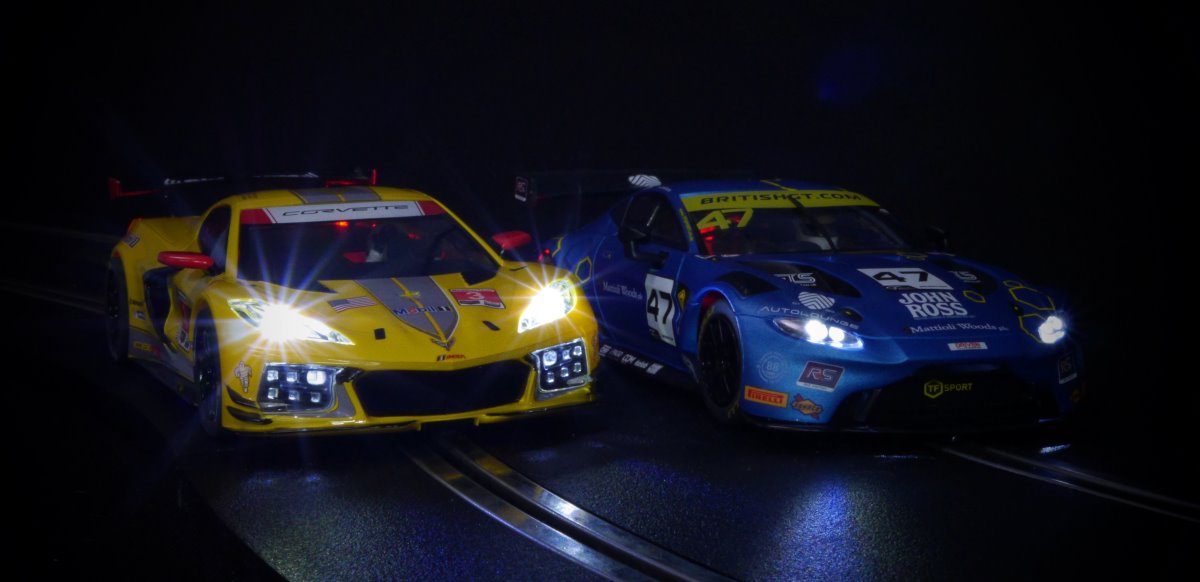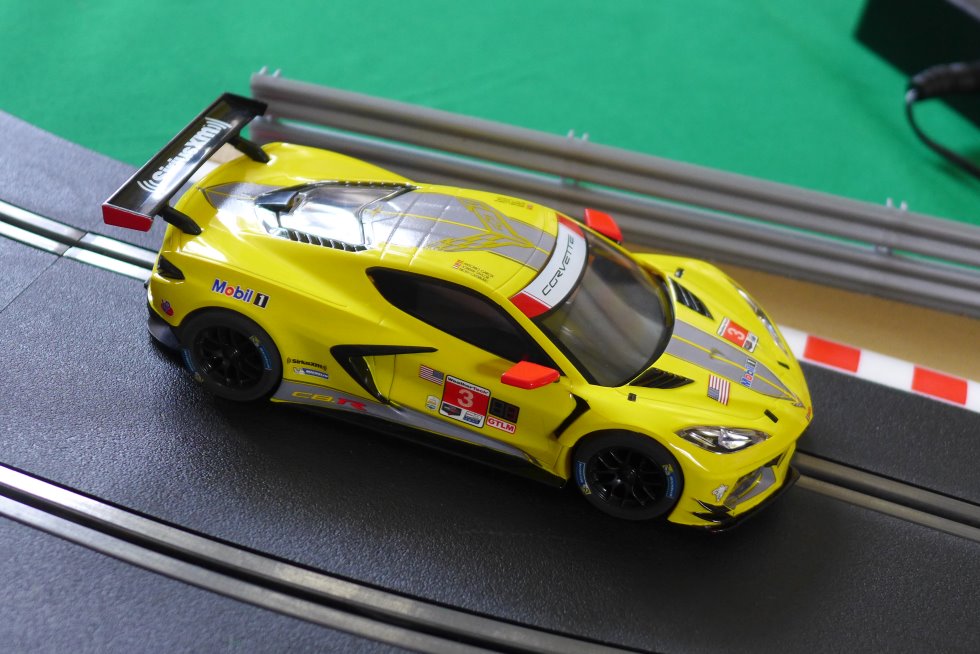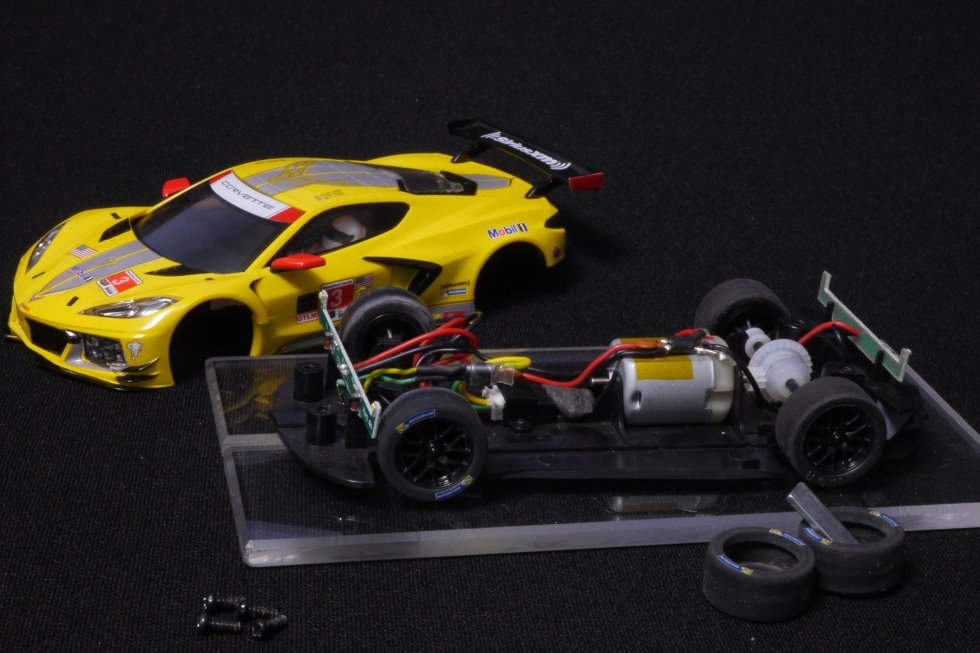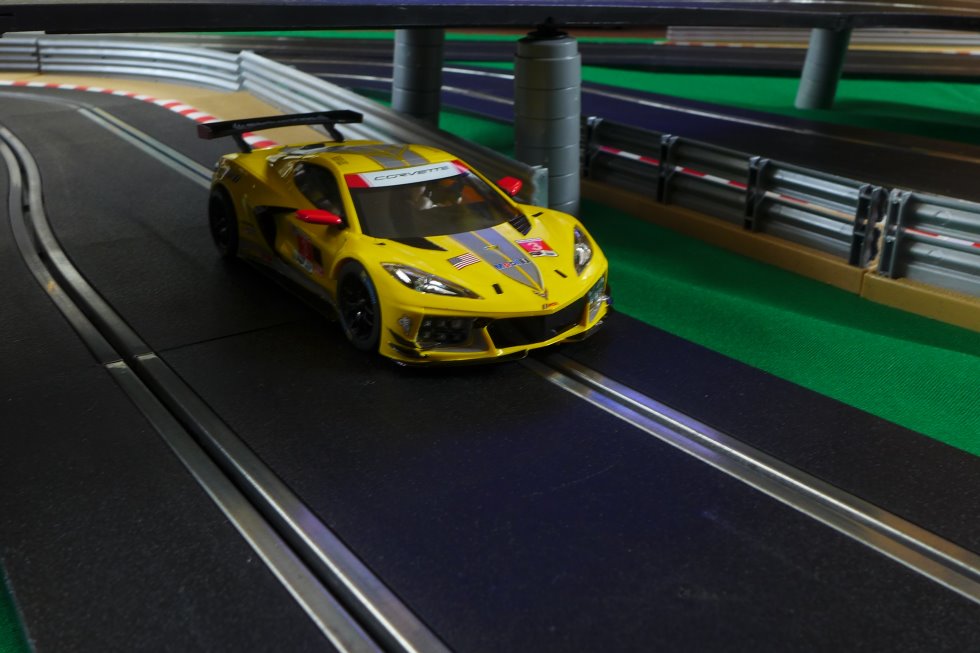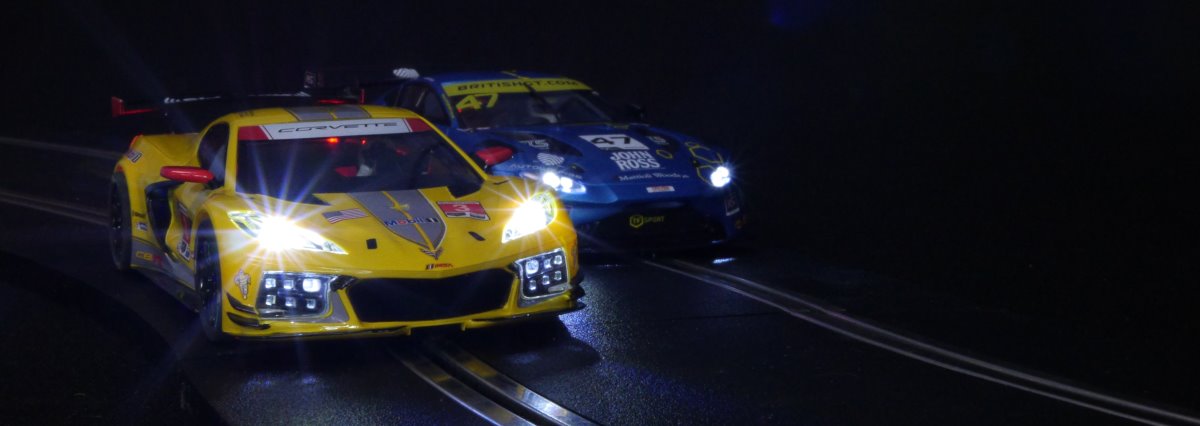The ‘Vette looks fabulous, but how does it perform?
Back in February, I took the undecorated ‘Test Shot’ sample for a spin. It showed a lot of promise – as you can read back in Part 2 of the Corvette story. The final signed sample the Scalextric team have loaned me is a big step forward – the tooling has been refined and the decoration developed to the point where everyone is happy. The bright yellow car certainly looks amazing and is nearly ready for the full production run, shipping to Hornby’s British, North American and Australian warehouses – and then on to Scalextric retailers and us, the customers.
Before I look at those final stages, I wanted to give the pre-production model a full road test. I’ll put the Corvette through its paces – with and without the traction magnet – on the Jadlam SL6 test track. And I’ll compare it with the best of last year’s GT cars, the Aston Martin Vantage GT3. As this is the final pre-production version, I’ll also include a data sheet with all the important measurements.
Don’t forget, you can pre-order the #3 yellow Corvette C8R here: www.jadlamracingmodels.com/scalextric-slot-car-c4246-chevrolet-corvette-c8r-24hrs-daytona-2020-catsburg-garcia-taylor and its silver sister car here: www.jadlamracingmodels.com/scalextric-slot-car-c4240-chevrolet-corvette-c8r-24hrs-daytona-2020-fassler-gavin-milner/
Initial Impressions
As you should know by now, the Jadlam SL6 test track is tight and twisty – 10.6 metres long and with mostly Radius 2 corners, plus one Radius 1 right hander. It’s a fun track to drive and a good test of a car. I run the layout with an ARC Air powerbase, choosing from the various throttle curves in the app and using a two minute Endurance race to time the cars.
My first laps with the Corvette told me I needed a linear profile to get the car behaving as I wanted. As I found in February, the car loves being pushed and slides nicely at the back. The tyres on this sample certainly had more grip than the test shot, which made it easier to drive – and quicker. I was really enjoying driving the car – the controlled slides and flicks through right-left combinations were a lot of fun. The Corvette has a great feel to it, although once or twice I slid the rear too far and it spun out.
The Corvette is pretty wide at the back – I measured it at 66mm across the rear wheels. That width and the low centre of gravity gives the car good stability. The original test shot had its tyres sticking out beyond the wheel arches. This pre-production sample has them inside – just about… That might be an issue for some racing groups that insist tyres must be inside the edges of the wheel arches – or have a maximum ‘rear track’ measurement. There seems to be a millimetre of play each side to work with.
I realised I’d been running the car for a good 10-15 minutes and the motor was getting a bit warm! I stopped, took some photos, grabbed a cup of tea and then set up the ARC app for a couple of two minute timed runs. The first stint was seeing how far I could push the car – and then settle into a rhythm. I went straight into a second two minutes – and was on a good pace from the start.
The key thing for quick times is not to have too much fun with tail slides and flicks – precision and keeping the car straight is what matters. I was happy with the run and managed 26 laps and a best time of 4:23 seconds. That was out of the box, no tweaks or modifications – and with a car that looked like it had never turned a wheel. As you can see from the SL6 leaderboard, that’s bang on the Scalextric GT3 pace – although the other cars have benefited from my three basic tweaks.
Non-Magnet Test
My main interest in the Scalextric GT cars is digital club racing – they make perfect non-magnet digital race cars. For digital you really don’t super-quick cars – as a driver you need time to think and to plan overtakes and pit stops. In my mind, that’s what makes the Scalextric cars better than performance brands for multi-car digital racing. Of course, to run a realistic GT endurance race – an hour, two hours or three hours – the magnet has to come out, because otherwise the motor would burn up. The Scalextric GT cars do perform well with the traction magnet removed, although replacement rear tyres (NSR or Slot.it) and a small amount of weight do help. I explored non-mag set-ups in Part 9 of my Scalextric Tuning Series.
To prepare the Corvette C8R for a non-mag track test, I carefully removed the magnet from behind the motor. To do this, I took out the rear axle, lights and the diffuser assembly. That gave me space to lever up the magnet from one of the side clips holding it in. I replaced the standard tyres with a pair of NSR5230 Supergrips and added a 2.5g piece of tungsten putty to the underpan, just in front of the motor. I replaced the body and loosened off the screws one turn.
The non-mag ‘Vette was beautiful to drive – the car was planted with moderate amounts of rear-end slide. The driving experience was more consistent and predictable than with the magnet fitted – and I could push it quite hard into the corners. Playing with the throttle settings in the ARC app, I chose Profile B – which is more punchy than I’d usually have with a non-mag car. I was really enjoying myself, but stopped so I could get a timed run in the bag. Over two minutes, I did 23 laps and a best lap of 4:96 seconds. That is far the best non-mag performance of a Scalextric car on the SL6 layout – and identical to that of my NSR Porsche 997 with the same tyres and weight. I am sure I could get the Corvette going even better with a little more tweaking.
Corvette vs Aston Martin
So how does that compare with the best GT3 car of 2020? When I tested the TF Sport Aston Martin Vantage GT3 back in June, I had to work on the rear tyres to get adequate grip. Having done that, I managed 26 laps in two minutes, with a fast lap of 4:15 seconds – very similar to the Corvette’s 26 laps and 4:23 seconds. That was with magnets. Since then, I have removed the magnet from the Aston – it comes out very easily. I fitted the same NSR tyres and the same 2.5g of weight in front of the motor.
The Aston is lighter than the Corvette – 84g to 90.5g and the body weighs 3g less – but otherwise they are very similar cars. One big different is in the rear track – the width across the rear wheels. The Corvette is 66mm, the Aston 62.5mm. On the SL6 layout, the Aston didn’t feel as planted as the Corvette. Like the ‘old’ sidewinder Vantage, the new car is easy to drive, but the rear gets loose. I felt I couldn’t push as hard as I could with the ‘Vette. The proof would be in the data… and over two minutes, the Aston clocked 22 laps and a best of 5:32 seconds. That’s actually very good for a non-mag Scalextric car on the SL6 layout – but the Corvette did significantly better.
I have to say I was pleasantly surprised how good the Corvette was without magnets. The 2020 Aston is a great car and I expected it to be a tough benchmark in the head-to-head. The Corvette went one lap further and was 0.36 seconds quicker on its best lap. That’s very impressive.
Whether you’re a collector of Scalextric GT cars or a racer, make sure you get one – or both – of these Corvettes. They are expected to arrive in December. In the final part of the Corvette story, I’ll be looking at the journey from the factory through to the customer. We’ll be hearing again from the Scalextric team, meeting the crew at Jadlams and getting a little local knowledge from southwest China.
Scalextric Chevrolet Corvette C8R – 24hrs Daytona 2020 “Catsburg Garcia & Taylor” Data Sheet
Catalogue code: C4246
Range: Scalextric Modern GT Cars – 1/32 scale / high detail / Digital Plug Ready (DPR)
Released: December 2021
Spares included: 2 x braid plates with braid fitted
Lights: front and rear
Motor: Scalextric ‘short-can’ – inline orientation.
Gear ratio: 9:27
Length: 148mm
Wheelbase: 84.5mm
Rear axle width: 66mm
Height: 35mm
Weight: 90.5g (body = 32.5g)
Andy’s downforce gauge: 38g magnetic downforce


